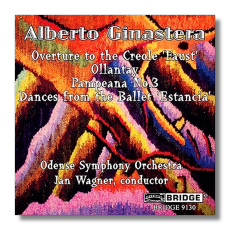
The Internet's Premier Classical Music Source
Related Links
- Ginastera Reviews
- Latest Reviews
- More Reviews
-
By Composer
-
Collections
DVD & Blu-ray
Books
Concert Reviews
Articles/Interviews
Software
Audio
Search Amazon
Recommended Links
Site News
 CD Review
CD Review
Alberto Ginastera

Orchestral Works
- Overture to the Creole "Faust"
- Ollanta
- Pampeana #3
- Estancia: Four Dances
Odense Symphony Orchestra/Jan Wagner
Bridge 9130 DDD 56:55
It's a small world. Here's an American label recording a Danish orchestra and a Venezuelan conductor in music by an Argentine composer whose parents were Catalan and Italian. Alberto Ginastera's almost garishly colorful music makes him the Ottorino Respighi of South America, if you will. (His later music took him into serialism, but that period of his career is not represented on this CD.) Like many classical composers, Ginastera (1916-1983) incorporated music from his homeland into his scores. At first, he treated his source material literally, but later, he integrated it into his own maturing style.
The works on this CD were written over a period of eleven years (1943-1954). The strong native elements heard in the Overture to the Creole "Faust" and Estancia are treated more subjectively in Ollantay and Pampeana #3. The Overture is based on a poem describing the impressions of a Creole gaucho, a cowboy of sorts, who came to Buenos Aires and saw a production of Gounod's Faust. Ginastera cleverly weaves several themes from the opera together with elements of Argentine folk music. Estancia is a ballet about life on an Argentine ranch, and the suite of dances included here ends with the almost orgiastic "Malambo," surely Ginastera's most famous music.
Ollantay, according to Incan legend, was the son of the Earth. Ginastera's three symphonic movements depict three episodes from his life. The word "pampeana" suggests sounds and impressions derived from the Argentine pampas or grassy plains. Ginastera subtitled his Pampeanas #3 a "Symphonic Pastoral in three movements." This was a transitional work for the composer in the sense that he was beginning to move away from music that had a single and decisive tonal center. Both Ollantay and Pampeanas #3 can be compared to the work of Heitor Villa-Lôbos, although they are more forward-looking than most of Villa-Lôbos's music.
Wagner and the Odense Symphony Orchestra go beyond playing these works as mere virtuoso showpieces. They seem to have a good feel for the idiom, and the orchestra plays with polish. Excellent engineering makes this CD all the more attractive. The most direct competition comes from Dorian Recordings's discs with the Simón Bolívar Symphony Orchestra of Venezuela, conducted by the late Eduardo Mata and Maximiano Valdes. (Also, Conductor Gisèle Ben-Dor has recorded an outstanding complete Estancia with the London Symphony for Conifer Classics.) Bridge's program is a unique Ginastera primer, however, and neither the performances nor the engineering need take a back seat to the Dorian CDs.
Copyright © 2003, Raymond Tuttle




















